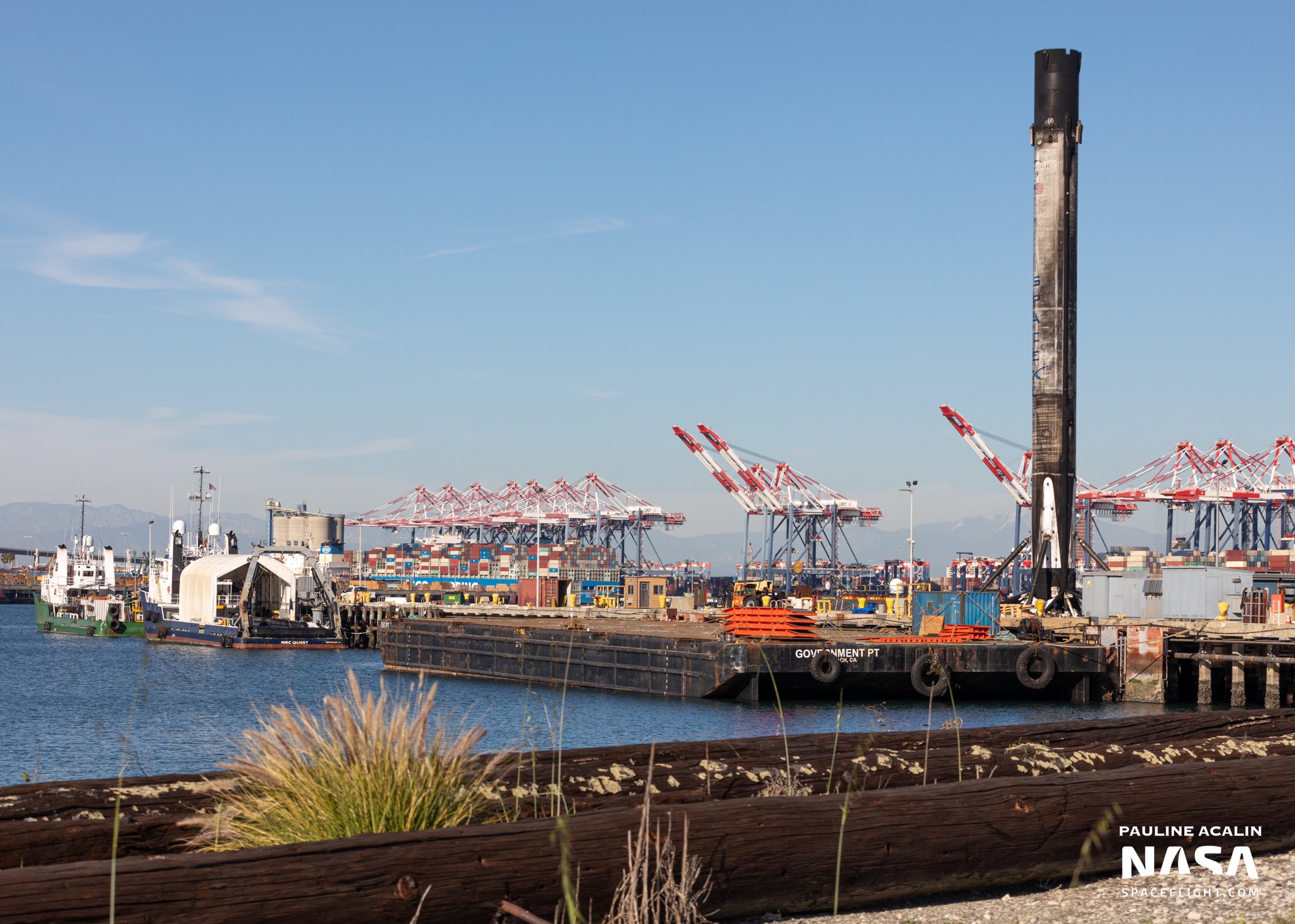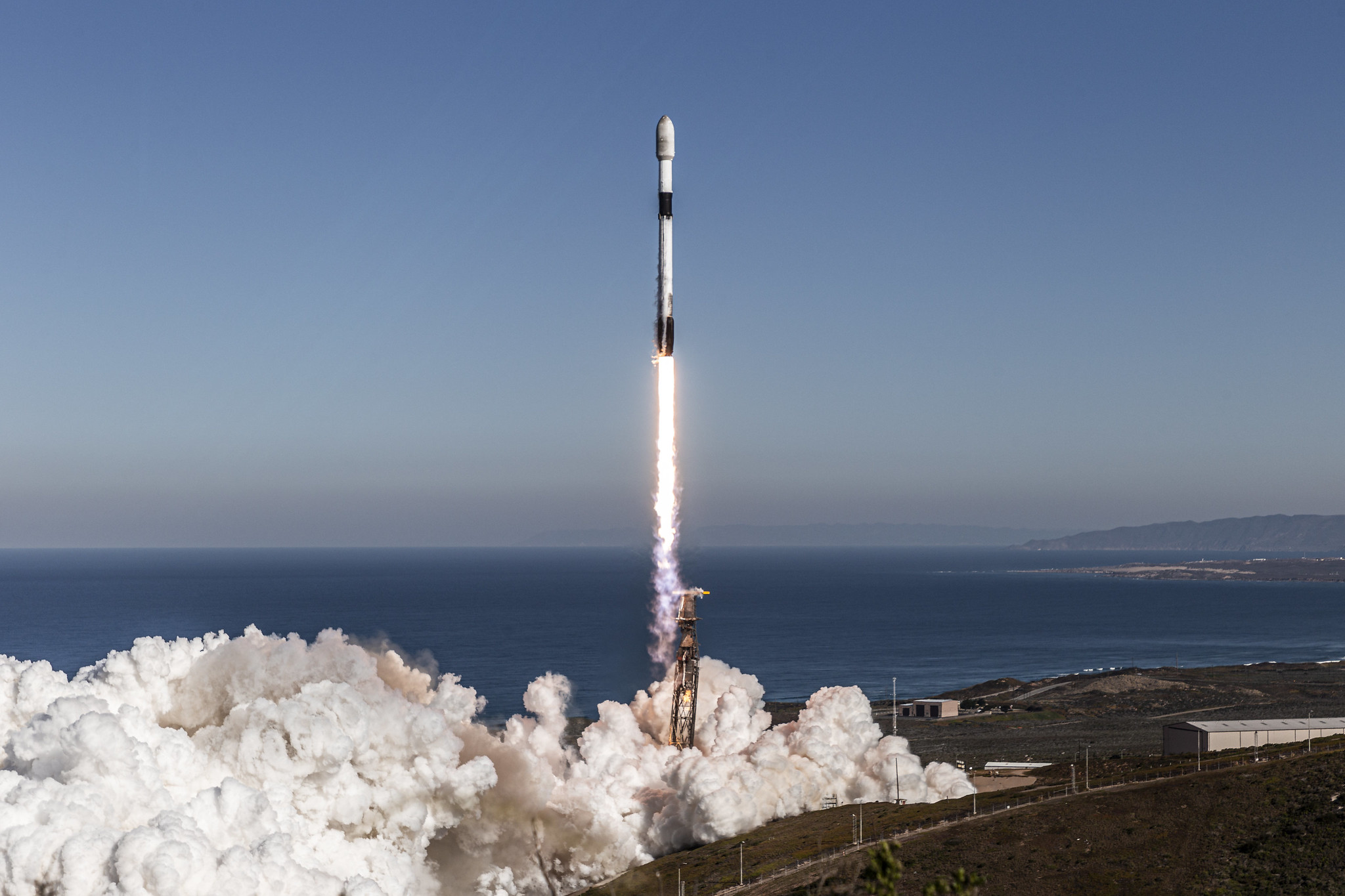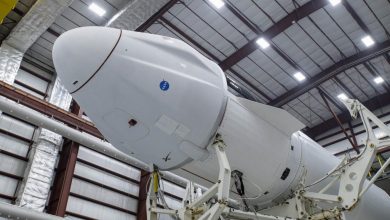
Lead Image: At 5:42 a.m. EDT Friday, June 29, 2018, SpaceX’s Dragon spacecraft lifts off on a Falcon 9 rocket from Space Launch Complex 40 at Cape Canaveral Air Force Station in Florida. Dragon is carrying more than 5,900 pounds of research, equipment, cargo and supplies that will support dozens of scientific investigations aboard the International Space Station. NASA astronauts Ricky Arnold and Drew Feustel will use the space station’s Canadarm2 robotic arm to capture Dragon when it arrives at the station on Monday, July 2. Image Credit: SpaceX
SpaceX launched its third back-to-back Starlink mission in barely a fortnight Friday. Falcon 9 lifted off from Vandenberg Space Force Base at 3:07 PM PDT (22:07 UTC) to add another 53 satellites to SpaceX’s low Earth orbit communications constellation, bringing the total launched to over 2,500.
The Starlink Group 4-13 launch continued a run of Starlink launches that has seen three missions in just over 14 days, using all of SpaceX’s Falcon 9 launch pads at Cape Canaveral, the Kennedy Space Center, and now Vandenberg. Two further launches, using both of the East coast pads again, are also expected in the coming week.
Friday’s launch took place from Space Launch Complex 4E (SLC-4E) at the west-coast launch site, and entered a 53.2-degree orbit in the fourth shell of the Starlink constellation.
An individual Starlink satellite masses a little under 300 kilograms, although SpaceX has not published a specific mass. They are typically launched in large batches – 53 are aboard Falcon 9 for the Group 4-13 launch – using a novel deployment mechanism that allows all spacecraft to be released from the rocket at once when they have reached their planned orbit.
As currently designed, the first-generation Starlink constellation will consist of 4,408 satellites. Before Friday’s launch, 2,494 satellites had been launched; however, this number includes over 240 that have already been decommissioned, failed after deployment, or rejected during on-orbit testing. The addition of another 53 satellites brings the total launched up to 2,547.
The first-generation Starlink constellation is divided into five shells, with most recent launches focusing on filling the fourth shell. This resides in a circular orbit at an altitude of 540 kilometers and an inclination of 53.2 degrees. The shell is divided into 72 planes with 22 satellites per plane, for a total of 1,584 satellites once all have been deployed and are operational.
A big factor in SpaceX’s ability to deploy the Starlink constellation so rapidly has been its Falcon 9 rocket. Not only does SpaceX have more control over launch manifests and operations by flying on its own rocket, but Falcon 9’s reusability also allows it to support a high flight rate. SpaceX has also been more willing to take risks with Starlink missions than they can with customer payloads, allowing them to push the envelope in terms of the number of times boosters can be re-flown and how quickly they can be turned around between launches.
Nowhere has this been clearer than with the two previous launches. The Starlink 4-16 mission, which lifted off from the Cape Canaveral Space Force Station on 29 April, set several new records for Falcon 9 boosters, most notably the fastest turnaround time for a booster: B1062 had previously supported the Axiom-1 launch earlier the same month. Starlink 4-17 launched from the Kennedy Space Center on 6 May, marking the twelfth flight for booster B1058 — bringing it level with B1051 and B1060 as SpaceX’s most-flown cores.
By rapidly and repeatedly turning around Falcon 9 boosters, SpaceX can maintain its impressive launch cadence, allowing Starlink launches to be slotted into the manifest where rockets are not required to carry out missions for SpaceX’s customers. Falcon’s payload fairing can also be recovered and re-used, although the rocket’s second stage is expendable and a new one must be manufactured for each flight.

Following a Falcon 9 launch, the Starlink satellites are deployed into an initial orbit below their operational altitude, ensuring any satellites that fail to activate will quickly re-enter the atmosphere. Functioning spacecraft will first raise themselves into a more stable orbit to undergo checkouts before taking up their stations in the operational constellation.
In total, Friday’s launch was the 153rd flight of the single-core Falcon 9 rocket, and the type’s 152nd orbital launch — a single suborbital flight having been conducted to test the Crew Dragon spacecraft’s launch abort capabilities. To date, Falcon 9 has only suffered one in-flight loss of mission, which occurred on the rocket’s 19th flight back in 2015 with the CRS-7 Dragon ISS resupply mission. A second rocket was lost, along with the Amos-6 satellite it was to have carried into orbit, during fueling for a static fire ground test in September 2016.
With a long run of successes since these two incidents, Falcon 9 has become a highly reliable workhorse serving the US and international space industry. SpaceX has also demonstrated impressive consistency in returning and recovering the first-stage boosters. Since achieving its first successful recovery in December 2015 – on Falcon 9’s return to flight after the CRS-7 launch failure – SpaceX has quickly turned this once-experimental aspect of its missions into something that almost looks routine.

With Friday’s launch, SpaceX added to a run of 44 consecutive successful booster recoveries since B1049 was lost during a Starlink mission early last year. Launches of “flight-proven” Falcon 9’s have gone from being a noteworthy occurrence to the norm — indeed a completely new Falcon 9 is now a very rare sight. Despite the long string of successes and the importance of booster reuse to maintaining SpaceX’s launch cadence, recovering the booster remains secondary to the rocket’s primary task of delivering its payload into orbit.
The booster for Friday’s Starlink mission was B1063-5. A veteran of four previous missions, B1063 first flew in November 2020 to deploy the Sentinel-6 Michael Freilich satellite for NASA, the National Oceanic and Atmospheric Administration (NOAA), and the European Space Agency (ESA). This launch took place from Vandenberg and included a return-to-launch-site landing at Landing Zone 4 (LZ-4), located near the launch pad.
For its second launch, B1063 was transferred to the East coast, where it flew with sixty Starlink satellites in May 2021 and landed aboard the Autonomous Spaceport Drone Ship (ASDS) Just Read the Instructions in the Atlantic Ocean. Returning to Vandenberg, the booster was next used to launch NASA’s Double Asteroid Redirection Test (DART) mission in November 2021 and then the Starlink 4-11 mission with fifty satellites in February 2022.
Both the DART and Starlink 4-11 launches saw B1063 recovered downrange using the West-coast drone ship, Of Course I Still Love You (OCISLY). Friday’s launch again targeted a landing aboard OCISLY, which was stationed in the Pacific Ocean to receive the stage. Landing aboard the drone ship instead of returning to the launch site eliminates the need for the rocket to make a boostback burn, saving fuel and therefore performance that can instead be contributed to the primary mission.

West coast Falcon 9 launches take place from Space Launch Complex 4E (SLC-4E) at the Vandenberg Space Force Base. Used by Titan rockets up to 2005, the complex was completely renovated by SpaceX ahead of the first Falcon launch from Vandenberg, which was the sixth flight of the Falcon 9 overall in September 2013. SpaceX also secured the lease to SLC-4E’s sister pad, SLC-4W, which now serves as Landing Zone 4 for boosters returning to the launch site.
Following integration in SpaceX’s hangar close to the launch pad, Falcon 9 was moved into position and raised to the vertical using the transporter-erector (T/E), also known as the Strongback. The Strongback supports the rocket while it is at the pad and houses umbilical connections to the upper stage and payload fairing. During the late stages of the countdown, it rotated away from the rocket to its launch position.
Before the strongback was retracted, however, the rocket was fueled. This process began about 38 minutes before launch when the Launch Director gave the go-ahead for propellant loading to commence. At T-35 minutes, RP-1 propellant – rocket-grade kerosene – began flowing into tanks on both stages of the rocket, while loading of liquid oxygen (LOX) into the first stage tanks also began. Second stage LOX loading did not start until later in the countdown, at the T-16-minute mark.
The supercooled liquid oxygen used by Falcon 9 boils off from the oxidizer tanks as the countdown proceeds, and must continually be topped up until loading terminates and the tanks are pressurized with about one minute to go until liftoff. The final minute of the countdown also sees the onboard computer perform final pre-launch checks on the vehicle and the Launch Director give a final “go” for launch.

At T-3 seconds, the ignition command was sent to the nine Merlin-1D engines that powered the first stage. These ignited before the rocket lifted off at T0 and began to climb skyward. Pitching downrange, Falcon 9 maneuvered to its proper trajectory, offshore but following the coast as it headed southeast from Vandenberg. Falcon 9 passed through the area of maximum dynamic pressure, or Max-Q, about 72 seconds after launch.
The first stage, B1063-5, powered Falcon 9 for the first two and a half minutes of flight before shutting down its engines, an event known as main engine cutoff, or MECO. Four seconds after MECO, the first and second stages separated, with second stage ignition about six seconds later.
Falcon 9’s second stage is powered by a single Merlin Vacuum (MVac) engine, a version of the Merlin-1D optimized to operate most efficiently in the vacuum of space. This engine made two burns during Friday’s mission to deliver the Starlink satellites into their deployment orbit, with an additional deorbit burn after spacecraft separation to ensure the safe disposal of the upper stage.

The first burn of the second stage lasted six minutes and six seconds. About five seconds into the burn, Falcon’s payload fairing that protects the Starlink satellites during ascent separated from the nose of the rocket. At the end of the upper stage burn, second stage engine cutoff 1 (SECO-1), Falcon 9 started a coast phase.
The second stage coasted for 44 minutes and 54 seconds before restarting for a brief second burn, lasting just one second, to circularize its orbit. Nine minutes and one second after the end of this burn – SECO-2 – the Starlink satellites were deployed from the upper stage.
While the second stage carries out Falcon’s primary mission of delivering the Starlink satellites into orbit, B1063-5 returned to Earth. Shortly after separating, it carried out a flip maneuver to point its engines in the direction of flight. After deploying its grid fins to help control the stage during descent, it passed back into the atmosphere, firing three engines in an entry burn to help slow and protect the booster as it re-enters.
As it approaches the drone ship, Of Course I Still Love You, B1063-5 restarted its center engine and deploy its landing legs. The booster touched down on the deck of OCISLY about eight minutes and 33 seconds after liftoff. The drone ship will now bring the booster back to the Port of Long Beach to begin preparations for its next mission.
The rapid pace of SpaceX’s Starlink launches shows no sign of letting up. On Saturday, just 22 and a half hours after the Group 4-13 launch, another Falcon 9 will lift off from the Cape Canaveral Space Force Station with Group 4-15. Starlink Group 4-18 is due to lift off from the Kennedy Space Center next Wednesday.
The next Falcon 9 launch from Vandenberg is currently expected to be that of the German SARah-1 radar-imaging satellite, slated for no earlier than June.





